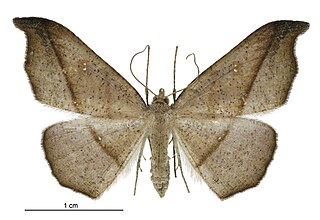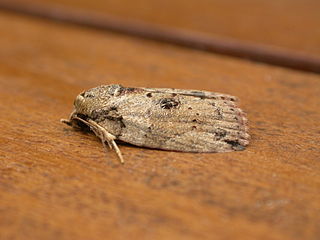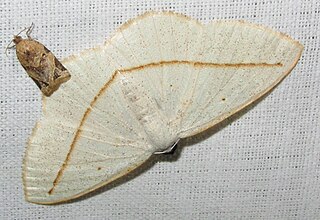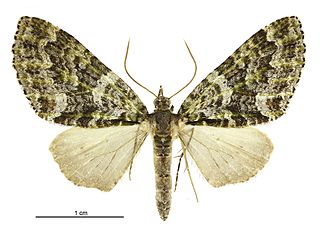
Nepita is a monotypic moth genus in the subfamily Arctiinae erected by Frederic Moore in 1860. Its only species, Nepita conferta, the footman moth, was first described by Francis Walker in 1854. It is found in India and Sri Lanka.

Cleora injectaria is a moth of the family Geometridae described by Francis Walker in 1860. It is found in the tropical regions of the Indomalayan and Australasian realms, up to Fiji and New Caledonia.

Epyaxa lucidata is a species of moth in the family Geometridae. It is endemic to New Zealand.
Argidava is a genus of moths in the family Geometridae erected by Francis Walker in 1863.

Eudulophasia is a genus of moths in the family Geometridae erected by William Warren in 1897.
Nadagara is a genus of moths in the family Geometridae first described by Francis Walker in 1861.

Sarisa is a monotypic moth genus in the family Geometridae and was first described by David Stephen Fletcher in 1979. The genus contains only one species, Sarisa muriferata, the hook-tip fern looper, which is endemic to New Zealand and surrounding islands. This species was described by Francis Walker in 1862. It is widespread in the North and South Islands, and has been recorded from Stewart Island, Big South Cape Island, the Chatham Islands and the Auckland Islands.

Nanaguna breviuscula, the pigeonpea pod borer, is a moth species of the family Nolidae. It is found from Sri Lanka and India east to Samoa. In Australia it is found in the Kimberleys in Western Australia, the northern part of the Northern Territory and from the Torres Strait Islands and Queensland to Sydney in New South Wales.
Scopula actuaria is a moth of the family Geometridae. It was described by Francis Walker in 1861. It is found throughout the Oriental tropics of India, Sri Lanka, from Afghanistan and Taiwan to the southern Moluccas and Timor. It is also found on the Chagos Archipelago.

Lomographa inamata is a moth in the family Geometridae first described by Francis Walker in 1860. It is found in Sri Lanka, Japan, China, India and Taiwan.
Scopula addictaria is a moth of the family Geometridae. It was described by Francis Walker in 1861. It is found in Sri Lanka.
Scopula aspilataria is a moth of the family Geometridae. It was described by Francis Walker in 1861. It is found in Sri Lanka.
Scopula emissaria is a moth of the family Geometridae. It was described by Francis Walker in 1861. It is found in India, Sri Lanka, Myanmar, Vietnam, China, Korea, Japan, the Philippines, Sumatra, Java, Wallacea and Australia.

Terina is a genus of moths in the family Geometridae erected by Francis Walker in 1854.

Macrobrochis gigas is a moth of the family Erebidae. It was described by Francis Walker in 1854. It is found in China (Yunnan), India (Sikkim), Bhutan, Nepal, Indonesia, Hong Kong and Taiwan. The habitat consists of woodlands.

Hyposidra talaca, the black looper or black inch worm, is a moth of the family Geometridae. The species was first described by Francis Walker in 1860. It is found from India to Indochina, Sundaland, Sulawesi, the Philippines, Sri Lanka, the Solomon Islands, Thailand, Taiwan, New Guinea and Australia, where it has been recorded from Queensland. It is a major defoliating pest in tea plantations.
Cusuma vilis is a moth of the family Geometridae first described by Francis Walker in 1854. It is found in Sri Lanka.

Tatosoma agrionata, also known as the mistletoe carpet moth, is a species of moth in the family Geometridae first described by Francis Walker in 1862. It is endemic to New Zealand. It is classified as at risk, declining by the Department of Conservation.

Notoreas perornata is a species of moth in the family Geometridae. It is endemic to New Zealand and is found in the North Island from Northland to Westland as well as in the South Island on the coast of Marlborough.

Paranotoreas brephosata is a species of moth in the family Geometridae. This species is endemic to New Zealand.













